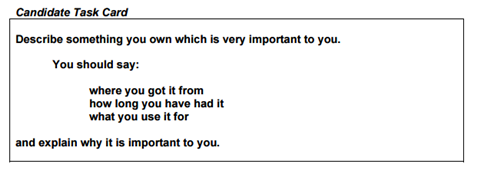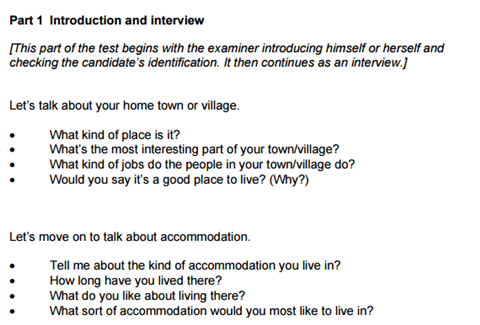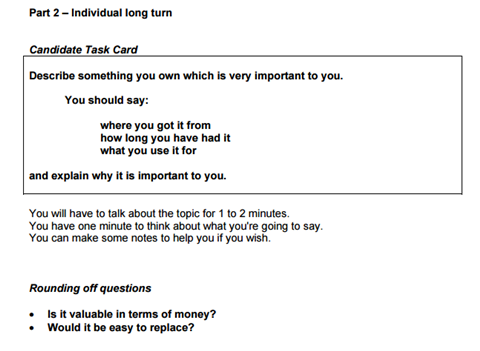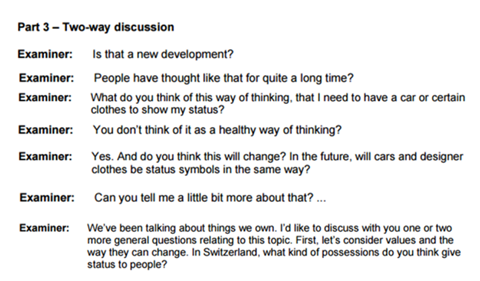In this article, IELTS teacher Iffaf Khan offers practical tips and strategies to help teachers improve students' conversation skills for the speaking test.
The speaking test is designed to assess a wide range of answers from candidates. In the first part of the exam, students encounter basic questions about daily life. The second part of the test requires students to speak for an extended period of time about one topic in relation to their life and experiences. The third and final part of the test has more general questions about the student's country, the world or life. To do well in the exam, students need to be confident talking about various aspects of their lives, have good general knowledge and be willing to express opinions on a range of topics.You’ll find more details about the format at: www.ielts.org/about-the-test/test-format-in-detail.
Sometimes students try to prepare for the exam by memorising answers. However, this is not a good idea as it can sound like they are reciting a speech and the examiner will recognise this. Also, when students are asked a question that they have not prepared for, they do not know what to say. It is much better for them to try and give natural, organic answers.
The following tips will help to get your students speaking and prepare them for the type of answers they need to give for each part of the test.
Tip 1: For part 2 – observation skills
Problem: In part 2 of the speaking test, candidates are asked to speak for two minutes. In these two minutes, they must tell a personal story (an anecdote) and/or describe a person, object or situation. Two minutes can feel like a long time if the candidate has not described their object or idea in detail and if they have only used limited adjectives. They need to do more than say something was ‘amazing'.
Solution: Ask them to practice talking about what they do or see. You could challenge your students to observe any object they see inside or outside the classroom and talk about it. Ask them to be specific about the object and to comment on it, using three questions and a list of different types of descriptive adjectives. After students have practised describing objects, they could develop ways to practise describing ideas or stories.
Instructions:
- Collect interesting objects from your home, your handbag, or even other classrooms. Please do this before the class.
- In class, bring out your collection of interesting objects.
- Ask the whole class to shout out what they see.
- Give them a list of different types of descriptive adjectives. It might look like this:
| Object | Opinion | Size | Shape | Condition | Age | Colour | Pattern | Origin | Material | Purpose |
|
potato |
tasty |
big |
dirty |
old |
brown |
Irish |
||||
|
cup |
broken |
China |
ceramic |
drinking |
||||||
|
window |
dirty |
large |
rectangular |
|||||||
|
clock |
loud |
round |
Swiss |
- Make sure your students understand the differences between each category of adjective.
- Ask them what they could say about your collection of objects. Try to help them. Give them three questions they have to apply to each object:
- Can you describe it?
- What does it do?
- How does it help you?
- Ask them to talk about each object with a partner.
- At the end of the activity, explain what part 2 of the speaking test is about.
- Help them understand why describing an object helps them to do well in this part of the speaking test.
- Ask them to bring in an object of their choice to class to talk about or to ask another student to talk about. This could be something like flowers, a bag or even a jacket.
- In another class, ask them to describe different jobs, but you could give extra questions, such as:
- How would you feel if you did this job?
- What makes this a good/bad job?
- In other class, ask them to describe different people, but you could give extra questions, such as:
- What do they look like?
- What are their good/bad characteristics?
Tip 2: For part 2 – talking for a long time without repeating yourself
Problem: Part 2 of the speaking test asks candidates to think about a topic for a minute and then talk about it for two minutes. It might look like this:

(from https://www.ielts.org/about-the-test/sample-test-questions)
Students see three points for what they should say in order to give a longer answer, but they still often find it hard to talk for at least two minutes.
Solution: Help them prepare their topics by asking them to have more than three ideas for each topic. You could ask your students to talk to each other, to help each other to brainstorm a topic in the same way as they would plan an essay. This not only gives them speaking practice, but it also gives them a chance to plan and prepare a topic. Remind them to always fully prepare the topic. They will then find it easier to fully develop and explain their ideas on the day of the exam. Prepare as many topics as you can and make the brainstorming similar to the kind of language in a part 2 task card (with who, what, where, when, why, how questions).
Instructions:
- In the middle of the board, write: 'Something important to me.'
- Draw the outline of a mind map from this, so that your board looks like this.
- Now replace 'something important to me' with an object which is important to you, like your watch.
- Fill in the rest of your mind map. Try and do it quickly. It might look like this, but it depends on what you want to say.
- Tell your students to listen carefully, in order to make sure you don’t repeat any point.
- Talk for a full two minutes about the object in your mind map and make sure you fully use all six points.
- Ask them to tell you how you did (about vocabulary, repetition or even how well-organised you were).
- Ask them to talk to their partner, in order to choose an important object, and then to plan six points for their talk. Give them as much time as they need.
- Monitor closely, to make sure that they don’t copy each other’s ideas.
- Ask one student to talk to their partner for a full two minutes. Keep an eye on the time and ask them to keep speaking until the time is up.
- Get their partner to give them feedback on repetition, vocabulary and on how well organised they were.
- Repeat with the other partner.
- Regularly give different topics and get them to discuss and fully plan each one. Try and do this every day.
Tip 3: For part 3 – get excited about bigger issues
Problem: Students who are a little younger or students who do not keep up with what is going on in the world might find it hard to talk about an economic crisis or the problem of the youth of today, but in part 3 they have to answer questions that encourage them to think about more than themselves. For students who memorise answers, this is very difficult because the candidate has to discuss an idea, agree or disagree with the examiner and have a real and natural conversation. The questions might look like this:

(from https://www.ielts.org/about-the-test/sample-test-questions)
Solution: Try and get your students to have real and natural conversations about big issues. If the topics are interesting, or if you can find a way to pull your student into the topic by personalising it and making it interesting for them, then you can have a real discussion with them. For example, instead of talking about the dangers of consumerism, you could talk to your students about how they would feel if they were a dolphin eating plastic. If you have students who always say, ‘I don’t know what to say,’ why not give them a topic every day that they can prepare at home?
Instructions:
- Choose topics each day of the week, so that students can prepare some at home. To find issues, bring the local newspaper to class or go online and find the ‘letters page’ in a newspaper, like here: www.theguardian.com/tone/letters. You could also try and write out topics that might interest your students, because you know which topics they will and won’t like.
- Take the topic they prepared the night before and put it on the board. It could be 'Why do we buy things when we see adverts?'
- Put your class into small groups.
- Ask each group to come up with at least five reasons why (or for whatever the topic is). By asking for five, you are ensuring that they have a detailed, longer discussion. Make sure that each member of each group notes down what they discussed.
- Move students into different groups. Ask them to discuss their ideas with their new groups. If there is a difference of opinion, ask them to challenge or explain the difference. In other words, they should have a real discussion.
- Stop the discussions after about 10 minutes and ask the whole class to share ideas that they particularly liked. This gives them a chance to explain or to practice explaining something bigger and more complex.
- Give them a topic to prepare for the following day, and also ask them to bring an idea for a new topic for discussion. Make sure that they don’t write sentences out at home and then read those sentences in class. Ask them to bullet point their ideas.
Tip 4: For the whole test – raising their awareness about their range and accuracy of grammar and vocabulary
Problem: We might know we are making a mistake, but we still say it. For example, a student might always say, 'In my opinion, I think …' even if they know that they do not need to say both phrases (we call this particular kind of mistake a redundancy). Sometimes, a student might only use the present tense when they are speaking. They know how to use the other tenses, but when they are speaking the errors come through. We call these fossilized errors, and they can be very hard to repair.
Solution: Try and make your students more aware of mistakes they are making by getting them to hear themselves and then notice their mistakes. They can then analyse them and hopefully think about what changes they could make. It is important for them to realise that thinking and knowing does not always mean that they can correct the mistakes when they are next speaking, but that over time it is possible to improve.
Instructions:
- Download the speaking criteria from www.ielts.org/ielts-for-organisations/ielts-scoring-in-detail before coming to class. You can also find it at www.ielts.org/~/media/pdfs/speaking-band-descriptors.ashx.
- Teach or review the descriptors for Grammatical Range and Accuracy, particularly the difference between ‘full range’ (for band 9), ‘wide range’ (for band 8), ‘mix of simple and complex’ (for band 6) and ‘basic’ (for band 5). Provide examples that fit each phrase, such as only using the present simple as basic.
- Teach or review the descriptors for Lexical Resource (which is the vocabulary). Focus on words like ‘idiomatic’ for bands 7, 8 and 9, and think of examples for different topics.
- Play the recordings of a speaking test from www.ielts.org/about-the-test/sample-test-questions and ask students to tell you what they liked (or felt could be improved) in each recording. They could be looking for idiomatic vocabulary (like the use of the word ‘posh’ in part 3) www.ielts.org/~/media/pdfs/115057_speaking_sample_task_-_part_3_transcript.ashx.
- Print off the questions that were used in the samples. They are as follows:



- Make sure that students know how to record themselves on their phones and how to save the recording. This is very important.
- As homework, ask students to record themselves answering these questions. It depends on the level of your class, as to whether you do part 1, 2 or 3, or all of it. Reassure your students that nobody will hear this recording.
- Tell your students to bring earphones into the next class (if they don’t already have them).
- In the next class, ask them to find their recording, plug their earphones in and then listen and transcribe what they said.
- On the board, write: Range of structures? Idiomatic?
- Ask them to read through what they have written and tell you what they think about what they said. It is best to do this in a tutorial, as you don’t want your students to feel embarrassed or self-critical in front of other students. You can then give them advice on what they could do differently.
- After the tutorials, get the students to work with a partner on what they could do or say differently next time, such as plan part 2 properly, or think of more synonyms.
- The following week, ask the students to record themselves again (with the same questions for a lower level class, or different questions for a higher level).
- Repeat the tutorials or, if your class is comfortable with the idea, discuss it in a plenary.
IELTS practical tips

Practical tips for teachers to help students overcome common problems in the IELTS exam.
- 1
- Currently reading
IELTS practical tips: Having conversations for the speaking test
- 3
- 4
- 5
- 6
- 7









No comments yet